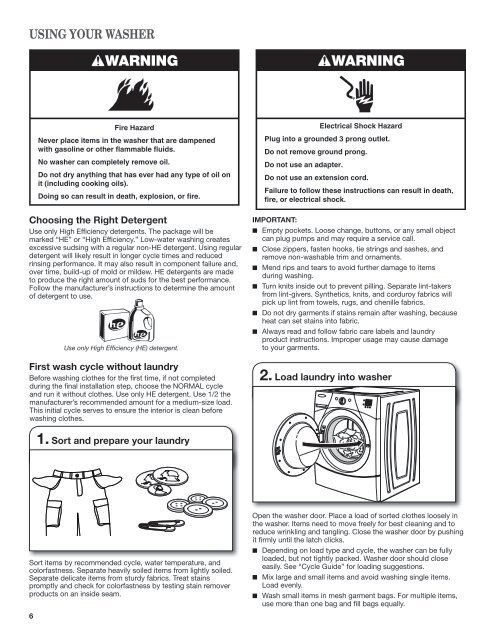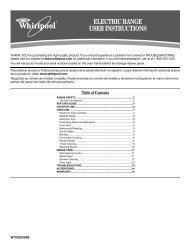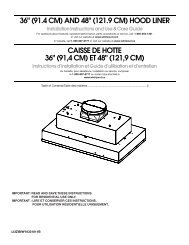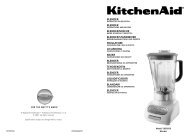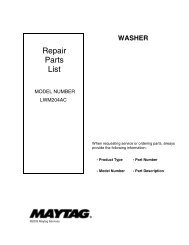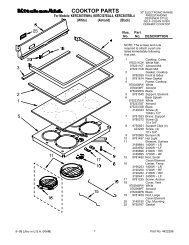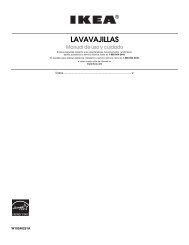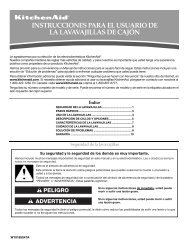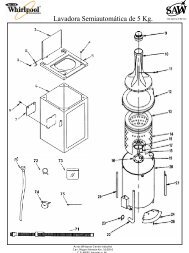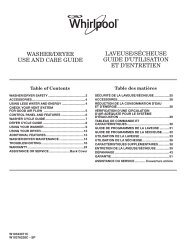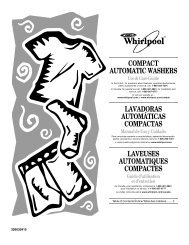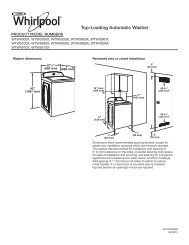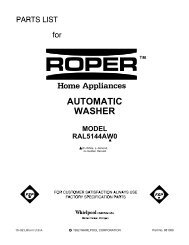front-loading automatic washer use and care guide ... - Whirlpool
front-loading automatic washer use and care guide ... - Whirlpool
front-loading automatic washer use and care guide ... - Whirlpool
Create successful ePaper yourself
Turn your PDF publications into a flip-book with our unique Google optimized e-Paper software.
USING YOUR WASHER<br />
Choosing the Right Detergent<br />
Use only High Efficiency detergents. The package will be<br />
marked “HE” or “High Efficiency.” Low-water washing creates<br />
excessive sudsing with a regular non-HE detergent. Using regular<br />
detergent will likely result in longer cycle times <strong>and</strong> reduced<br />
rinsing performance. It may also result in component failure <strong>and</strong>,<br />
over time, build-up of mold or mildew. HE detergents are made<br />
to produce the right amount of suds for the best performance.<br />
Follow the manufacturer’s instructions to determine the amount<br />
of detergent to <strong>use</strong>.<br />
Sort items by recommended cycle, water temperature, <strong>and</strong><br />
colorfastness. Separate heavily soiled items from lightly soiled.<br />
Separate delicate items from sturdy fabrics. Treat stains<br />
promptly <strong>and</strong> check for colorfastness by testing stain remover<br />
products on an inside seam.<br />
6<br />
Use only High Efficiency (HE) detergent.<br />
First wash cycle without laundry<br />
Before washing clothes for the first time, if not completed<br />
during the final installation step, choose the NORMAL cycle<br />
<strong>and</strong> run it without clothes. Use only HE detergent. Use 1/2 the<br />
manufacturer’s recommended amount for a medium-size load.<br />
This initial cycle serves to ensure the interior is clean before<br />
washing clothes.<br />
1. Sort <strong>and</strong> prepare your laundry<br />
IMPORTANT:<br />
n Empty pockets. Loose change, buttons, or any small object<br />
can plug pumps <strong>and</strong> may require a service call.<br />
n Close zippers, fasten hooks, tie strings <strong>and</strong> sashes, <strong>and</strong><br />
remove non-washable trim <strong>and</strong> ornaments.<br />
n Mend rips <strong>and</strong> tears to avoid further damage to items<br />
during washing.<br />
n Turn knits inside out to prevent pilling. Separate lint-takers<br />
from lint-givers. Synthetics, knits, <strong>and</strong> corduroy fabrics will<br />
pick up lint from towels, rugs, <strong>and</strong> chenille fabrics.<br />
n Do not dry garments if stains remain after washing, beca<strong>use</strong><br />
heat can set stains into fabric.<br />
n Always read <strong>and</strong> follow fabric <strong>care</strong> labels <strong>and</strong> laundry<br />
product instructions. Improper usage may ca<strong>use</strong> damage<br />
to your garments.<br />
2. Load laundry into <strong>washer</strong><br />
Open the <strong>washer</strong> door. Place a load of sorted clothes loosely in<br />
the <strong>washer</strong>. Items need to move freely for best cleaning <strong>and</strong> to<br />
reduce wrinkling <strong>and</strong> tangling. Close the <strong>washer</strong> door by pushing<br />
it firmly until the latch clicks.<br />
n Depending on load type <strong>and</strong> cycle, the <strong>washer</strong> can be fully<br />
loaded, but not tightly packed. Washer door should close<br />
easily. See “Cycle Guide” for <strong>loading</strong> suggestions.<br />
n Mix large <strong>and</strong> small items <strong>and</strong> avoid washing single items.<br />
Load evenly.<br />
n Wash small items in mesh garment bags. For multiple items,<br />
<strong>use</strong> more than one bag <strong>and</strong> fill bags equally.


